23 Ducks That Nest In Trees
Since most duck species spend much of their lives in and around water, it’s easy to assume that they all nest close to it. And for the most part, that’s true—many ducks build their nests amid vegetation along riverbanks, ponds, lakes, and other wetlands. But some species break the norm, opting for unusual nesting spots high above the ground. Yes, you read that right—certain ducks prefer tree hollows, cavities, and even old, dead trees. If you’re curious about which species have this remarkable habit, here’s a list of 23 ducks that nest in trees.
- 1. Black-bellied Whistling-Duck
- 2. Lesser Whistling Teal
- 3. Wood Duck
- 4. Common Goldeneye
- 5. Barrow’s Goldeneye
- 6. Common Merganser
- 7. Hooded Merganser
- 8. Bufflehead
- 9. Mandarin Duck
- 10. Smew
- 11. Bernier’s Teal
- 12. Muscovy Duck
- 13. Andean Teal
- 14. Spotted Whistling Duck
- 15. Scaly-sided Merganser
- 16. African Black Duck
- 17. Comb Duck
- 18. Ringed Teal
- 19. West Indian Whistling Duck
- 20. Paradise Shelduck
- 21. Torrent Duck
- 22. Ruddy Shelduck
- 23. Cotton Teal (Cotton Pygmy Goose)
1. Black-bellied Whistling-Duck

The Black-bellied Whistling-Duck is a lively and sociable bird with long legs and stunning pink bill. These ducks have a knack for choosing the most surprising nesting spots — hollow trees, palm trunks, chimneys, even abandoned buildings! In areas where natural cavities are scarce, they happily use nest boxes provided by people. They prefer wetlands and rice fields, where they feed on seeds, grains, and aquatic plants.
2. Lesser Whistling Teal

The Lesser Whistling Teal, also called the Indian Whistling Duck, is known for its gentle whistling call that you can often hear before you even see it. Unlike many ducks that nest on the ground, this species sometimes chooses tree hollows or abandoned bird nests to raise its young, especially in flooded forests or near quiet lakes. These ducks are mostly found in warm regions and are quite social, often seen in large flocks resting together. They feed mainly on seeds and aquatic plants, dabbling gracefully on calm waters.
3. Wood Duck
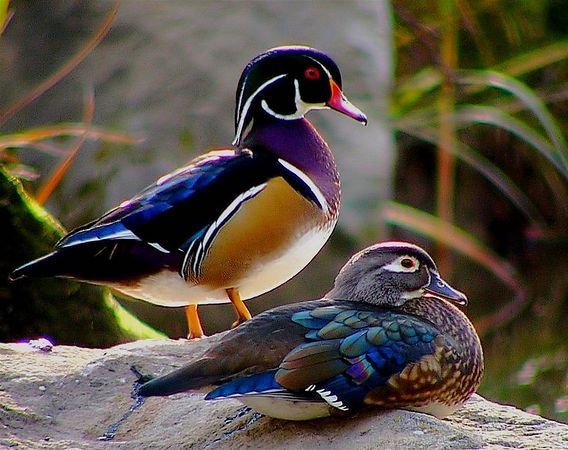
One of the most striking ducks in the world, the Wood Duck is famous not just for its rainbow-colored plumage but also for its unusual nesting habits. Instead of nesting on the ground, Wood Ducks prefer tree cavities near swamps, ponds, and wooded rivers. The mother lays her eggs high above the water, and when the ducklings hatch, they bravely leap from the nest to the ground below—bouncing safely thanks to their soft down feathers! Wood Ducks feed on acorns, seeds, and small insects, and their soft, high-pitched “oo-eek” call is a delight to hear during spring.
4. Common Goldeneye
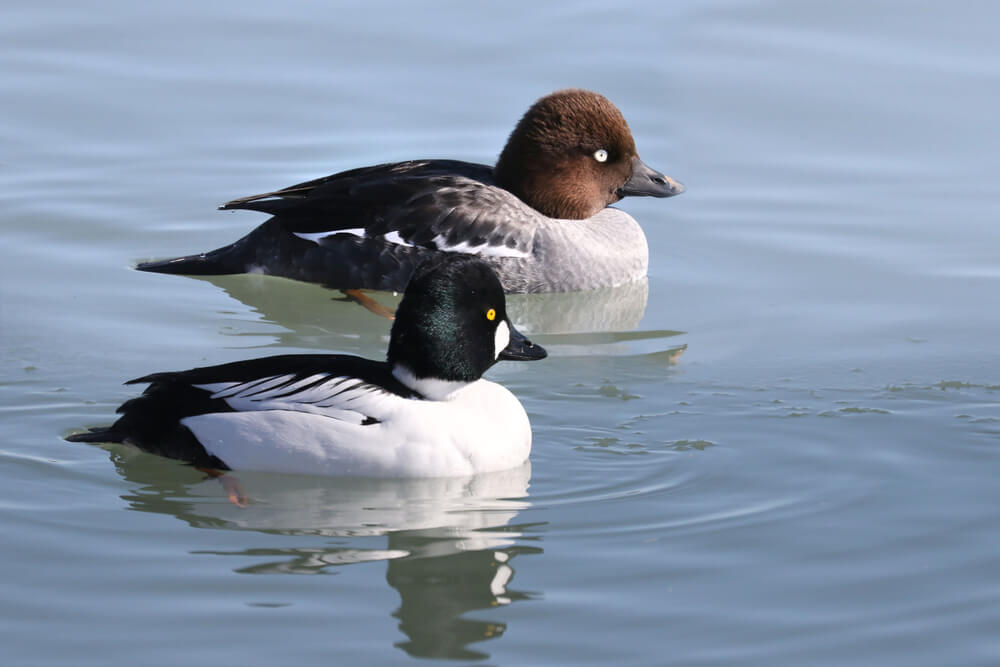
The Common Goldeneye gets its name from its bright yellow eyes that stand out beautifully against its dark head. These ducks like nesting in tree cavities near clear, forested lakes and rivers, often reusing old woodpecker holes. The female lines her nest with soft down to keep the eggs warm, and once the ducklings hatch, she leads them to nearby water to feed on insects, crustaceans, and small fish. In winter, they move south and can be seen diving gracefully in coastal bays or large lakes.
5. Barrow’s Goldeneye
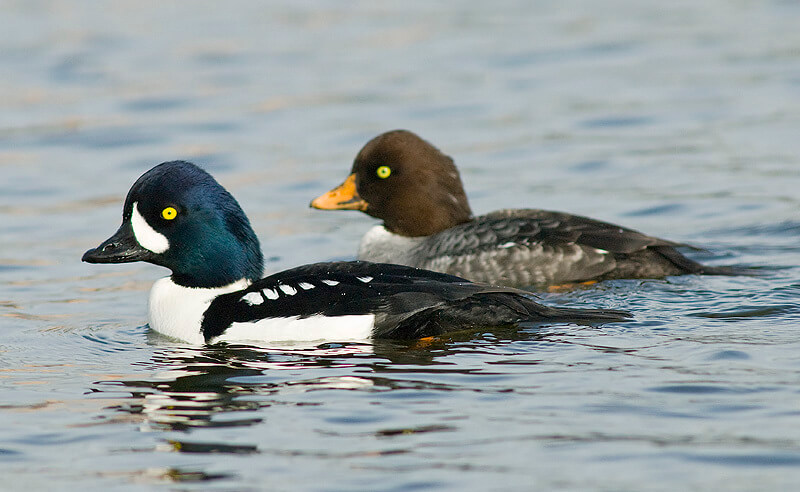
Closely related to the Common Goldeneye, Barrow’s Goldeneye prefers quiet, wooded lakes and forested rivers where tall trees offer ready-made nesting spots. They often choose natural tree hollows to raise their young, far above the forest floor. These ducks are expert divers and spend much of their time searching underwater for aquatic insects and snails. Their crisp black-and-white plumage and bright yellow eyes make them easy to spot, especially when sunlight reflects off the water. Though less common than their close relatives, they remain a favorite among birdwatchers for their beauty and lively behavior.
6. Common Merganser
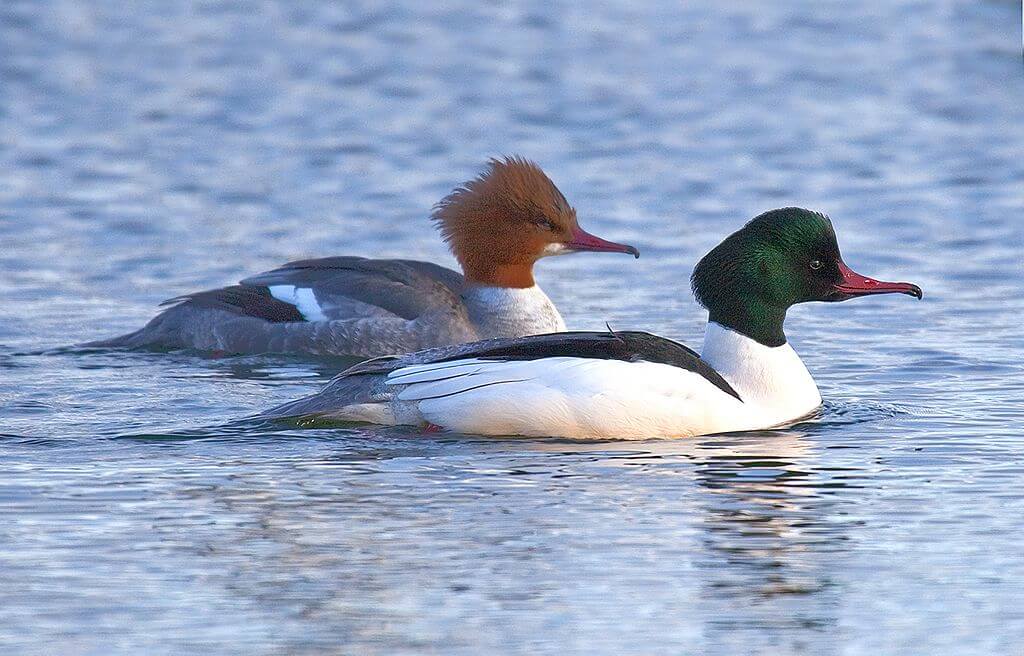
The Common Merganser is a sleek fish-eating duck often seen gliding on clear mountain rivers and forested lakes. Its narrow, serrated bill works like a comb, perfect for catching slippery fish. Females often nest in tree cavities close to water, sometimes in old woodpecker holes, lining their nests with soft down feathers. Once the chicks hatch, the mother leads them to water, where they start diving almost immediately. In winter, these ducks head to unfrozen lakes and coastal bays, where their graceful dives and flashes of white plumage are hard to miss.
7. Hooded Merganser
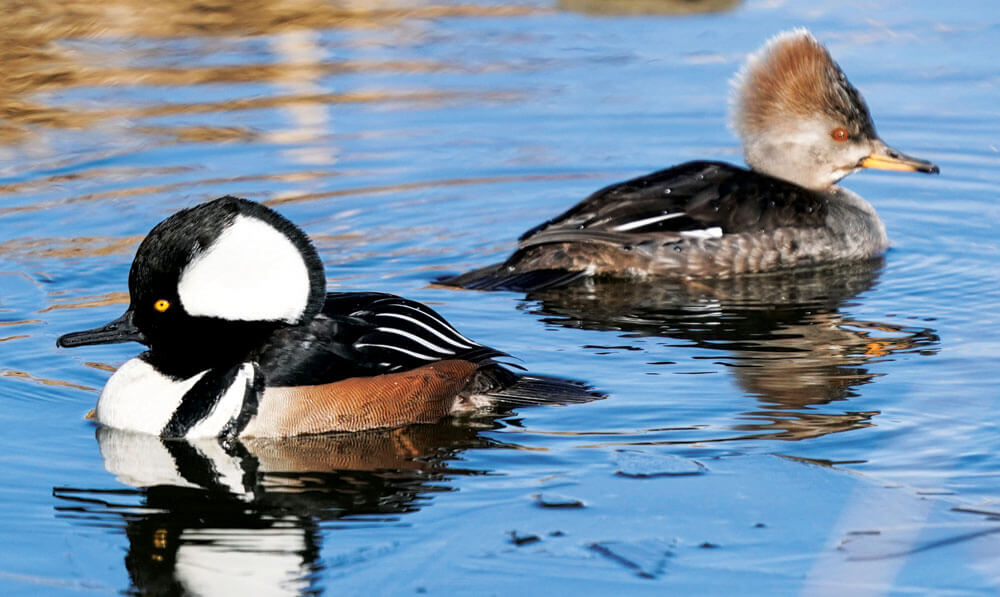
Small but striking, the Hooded Merganser stands out with its fan-shaped crest, which the male can raise or lower like a hood. These ducks love wooded ponds and rivers, where they look for tree hollows or nest boxes to raise their young. Like common merganser, the female usually nests high above the water, and when the ducklings hatch, they leap fearlessly to the ground and follow her to the nearest pond. Hooded Mergansers are superb divers and feed on small fish, insects, and crustaceans, often disappearing underwater for several seconds at a time.
8. Bufflehead

The Bufflehead may be small, but it’s full of character. Males sport a glossy green-and-purple head with a large white patch, while females have a more subtle beauty. These ducks rely heavily on tree cavities — often old nests made by Northern Flickers — to raise their young. They prefer small lakes and ponds in forested areas and are skilled divers, catching aquatic insects and crustaceans beneath the surface. In winter, you can spot them on sheltered coastal waters, where they dart and dive with remarkable energy.
9. Mandarin Duck
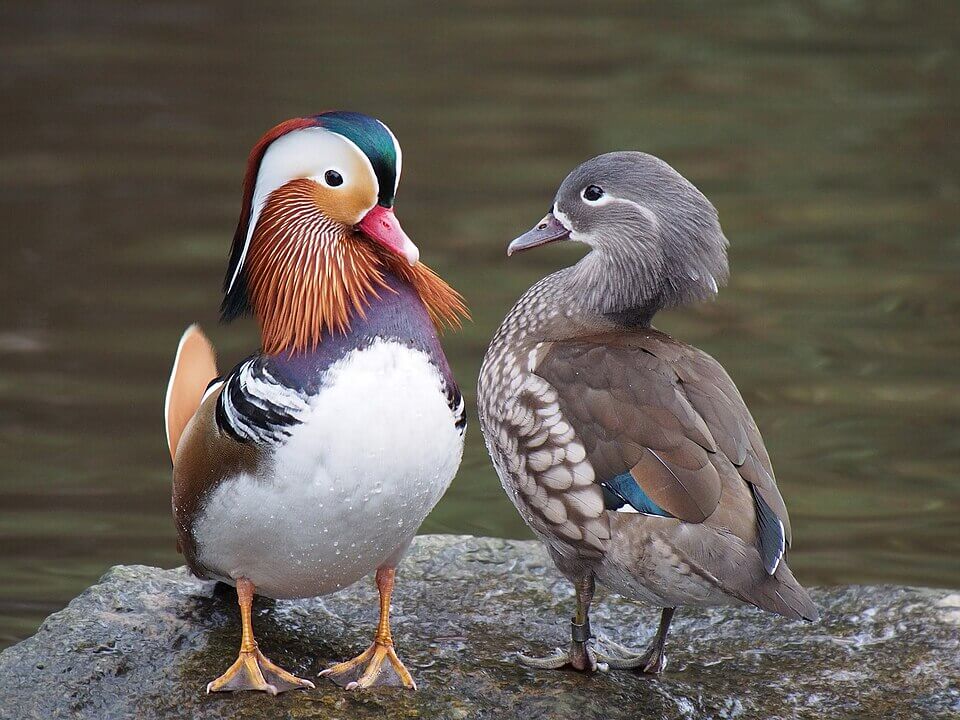
Few ducks are as breathtaking as the Mandarin Duck, with its mix of orange, green, and violet feathers. These ducks love quiet ponds surrounded by trees and often choose high tree holes to nest in. When the ducklings hatch, the mother gently calls them, and they jump from the nest — sometimes from heights of over 30 feet! Amazingly, they land unharmed and follow her to the nearest water. Mandarins are mostly found in East Asia but have also formed small wild populations in other parts of the world. Their beauty and unique nesting habits make them a true favorite among duck enthusiasts.
10. Smew

The Smew is a small, elegant diving duck known for its striking black-and-white plumage — the male looks almost as if he’s wearing a fine tuxedo. These ducks prefer to nest in tree cavities, especially old woodpecker holes near lakes and forested rivers. They’re not shy about using man-made nest boxes either, making them a joy for conservationists to support. Smews are excellent divers and feed mainly on small fish and aquatic insects. In winter, they migrate south, and birdwatchers often spot them on larger lakes and sheltered coastal waters.
11. Bernier’s Teal
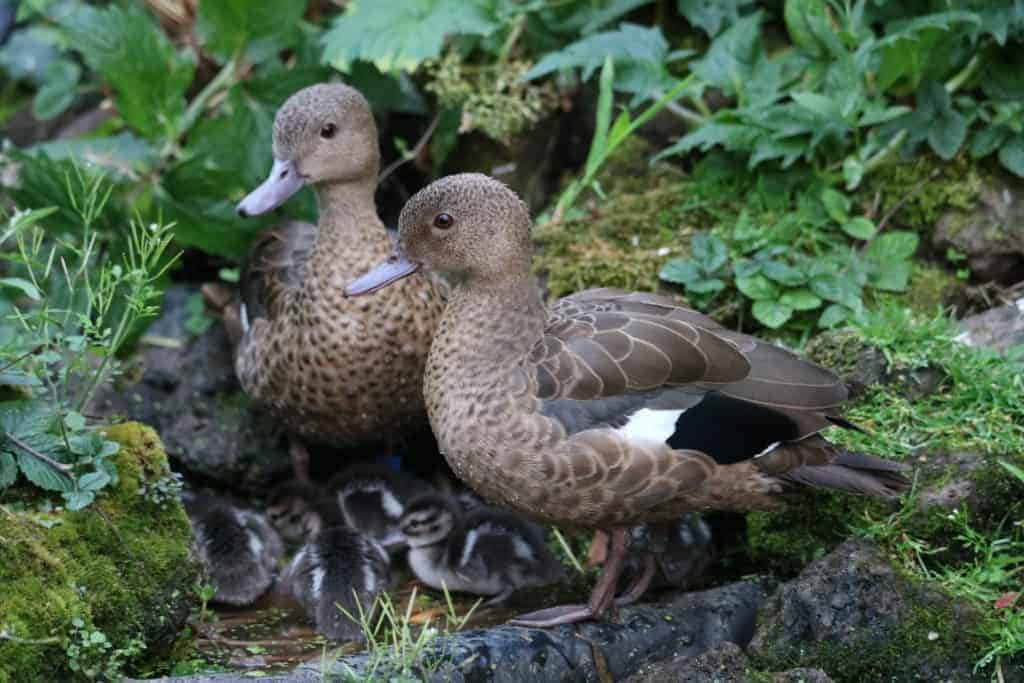
Endemic to Madagascar, Bernier’s Teal is a rare and fascinating duck that loves the quiet mangrove swamps of the island’s west coast. What makes it truly special is where it nests — inside holes of grey mangrove trees, often just a few meters above the water. The female lays her eggs directly on the cavity floor, first covering them with bits of wood, then with her own soft down. This teal feeds on small crustaceans, mollusks, and insects, dabbling gracefully among mangrove roots. Because it’s found only in Madagascar, protecting its delicate mangrove habitat is crucial for its survival.
12. Muscovy Duck
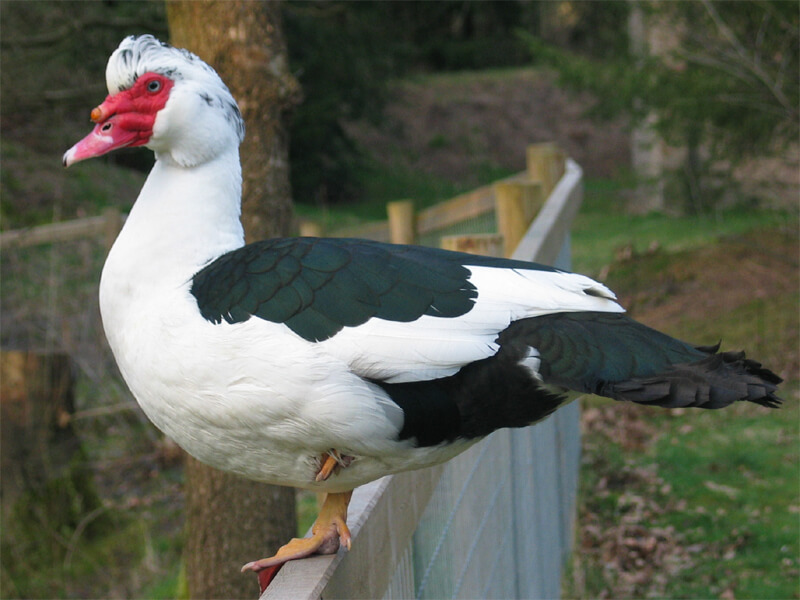
The Muscovy Duck is one of the largest tree-nesting ducks in the world. Native to Central and South America, it’s easy to spot with its glossy black feathers and bright red facial skin. Unlike most ducks, the Muscovy often chooses tall tree hollows for nesting — sometimes several meters above the ground. They are quiet birds, communicating with soft hisses instead of the usual quacks. Muscovies feed on plants, insects, and small fish, and although they’ve been domesticated in many parts of the world, wild populations still thrive in forested wetlands and along riverbanks.
13. Andean Teal
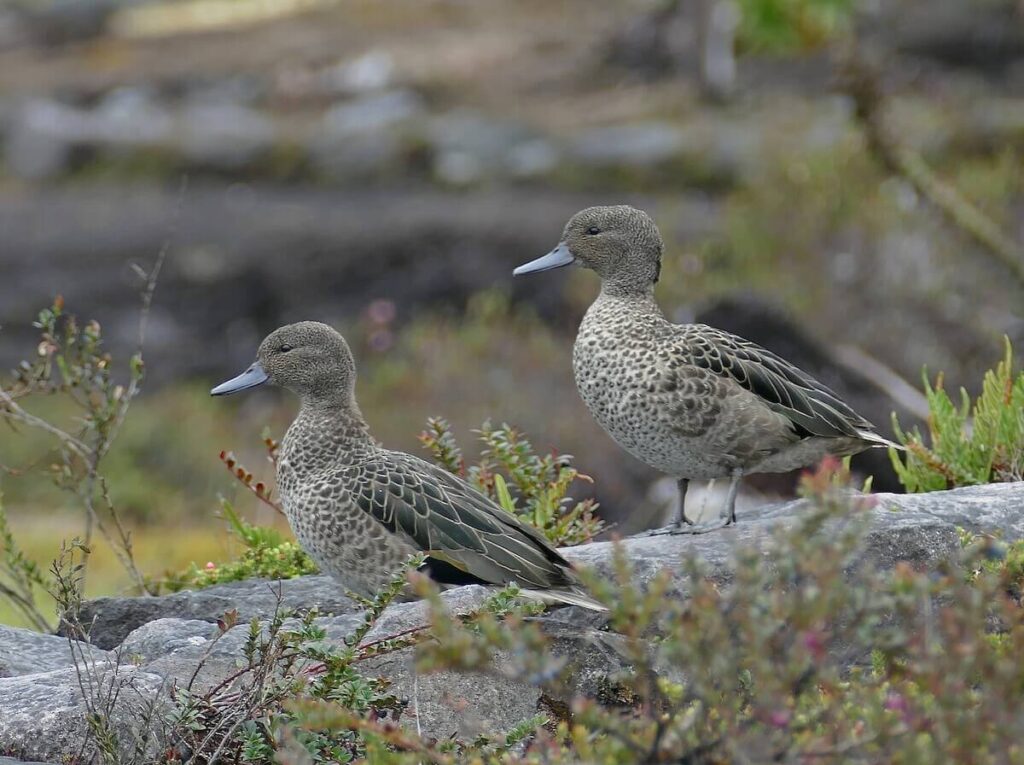
High up in the mountains of South America, the Andean Teal shows an amazing ability to adapt to different nesting sites. While many ducks stick to the ground, this species might choose the fork of a tree, a hole in a riverbank, an abandoned parakeet nest, or even the roof of a rural building! Such flexibility helps it survive in the rugged Andean landscape, where nesting sites can be scarce. These ducks enjoy feeding on aquatic plants and insects, and their soft, gentle calls echo beautifully across high-altitude lakes.
14. Spotted Whistling Duck
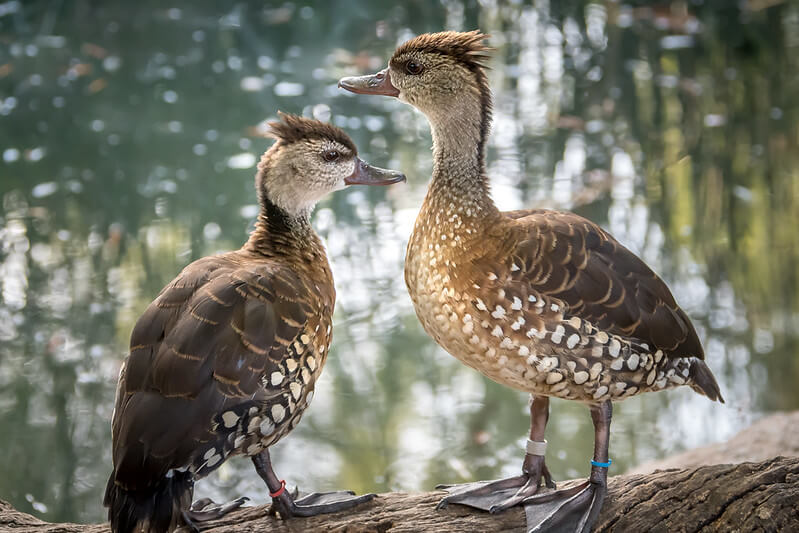
The Spotted Whistling Duck is easy to recognize by the soft white spots scattered across its darker feathers — and by its gentle, whistling voice. Unlike most of its relatives, this species is quite at home in trees. It often chooses tall, hollow trunks near lakes or rivers to build its nest, especially during the wet season. These ducks are social and often gather in small groups, feeding on seeds, grass, and aquatic plants. Their calm nature makes them a favorite among birdwatchers in tropical regions.
Discover other Spotted Ducks species: 20 Spotted Ducks That Stand Out With Their Unique Plumage
15. Scaly-sided Merganser

The Scaly-sided Merganser is a striking duck from East Asia, named for the scaly pattern on its white flanks. These shy birds prefer fast-flowing forest rivers and nest high in tall trees, where natural hollows keep their eggs safe and dry. The female lines the cavity with down, creating a warm, cozy nest far above the waterline. Sadly, they are considered endangered due to habitat loss, but conservationists are working hard to protect their forested river homes.
Discover other endangered duck species: 17 Most Endangered Ducks in the World According To IUCN Red List
16. African Black Duck
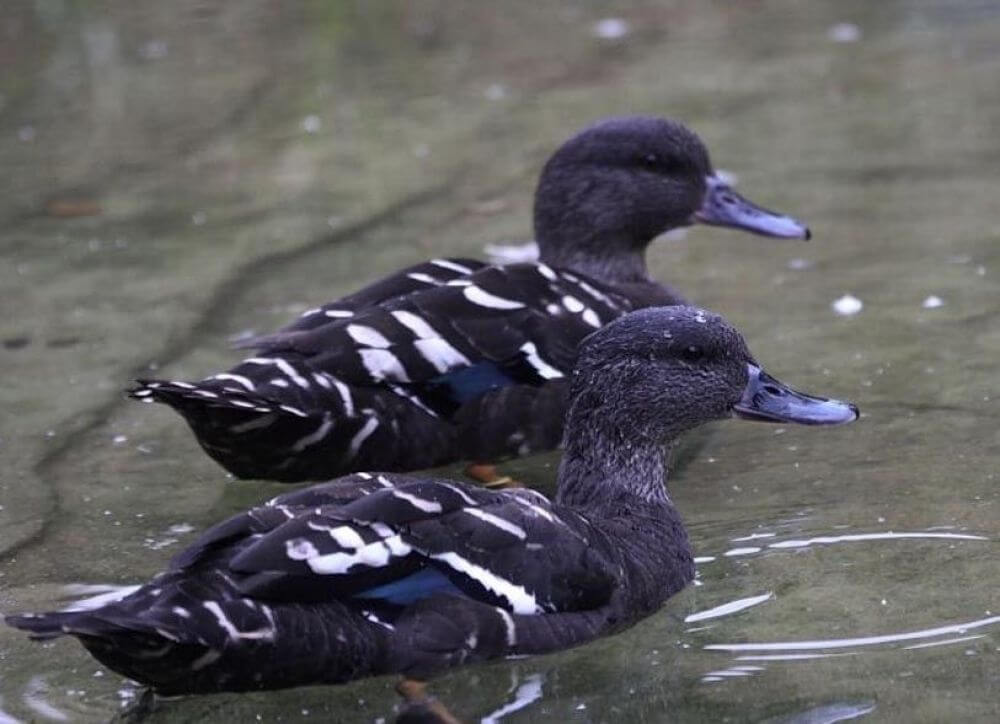
Dark and dappled, the African Black Duck blends perfectly with the shaded streams and rivers it calls home. Though it’s known mostly as a ground nester, a few have been seen using tree hollows above running water — a rare and fascinating behavior! These ducks prefer fast-flowing streams and rocky riverbeds, where they feed on aquatic plants, insects, and snails. They’re quite shy and often seen in pairs rather than large groups. Their quiet, steady presence adds a sense of calm to Africa’s riverine landscapes.
17. Comb Duck
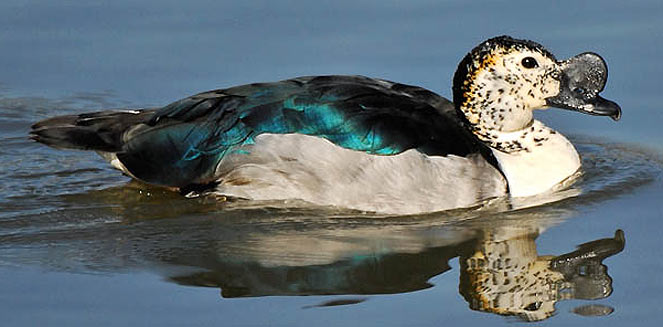
Named for the large, knob-like “comb” on the male’s bill, the Comb Duck is one of the most unusual tree-nesting ducks. They often choose tree cavities or even old bird nests built high above the ground, especially near wetlands and rivers. When no tree hollows are available, they adapt easily and nest among tall grass or rocks. Comb Ducks are strong flyers and excellent swimmers, feeding mainly on seeds, insects, and small aquatic creatures. Their habit of nesting high up gives their ducklings a dramatic start to life as they leap from the tree to join their mother below!
18. Ringed Teal
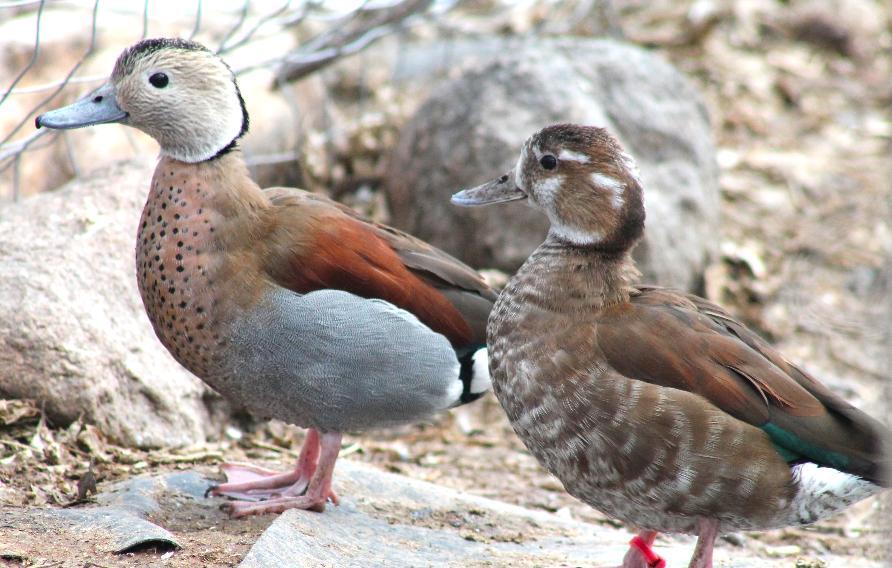
The tiny and charming Ringed Teal is one of South America’s most delightful ducks. With a bright pink bill, soft brown feathers, and a distinctive white ring around its eye, it’s easy to see why bird lovers adore it. Like many wood ducks, the Ringed Teal nests in tree hollows, often lining the nest with soft down for comfort. When the ducklings hatch, they must leap bravely from their elevated home to the ground — a heartwarming sight to witness. These ducks prefer quiet forest ponds and feed on seeds, insects, and small invertebrates.
19. West Indian Whistling Duck
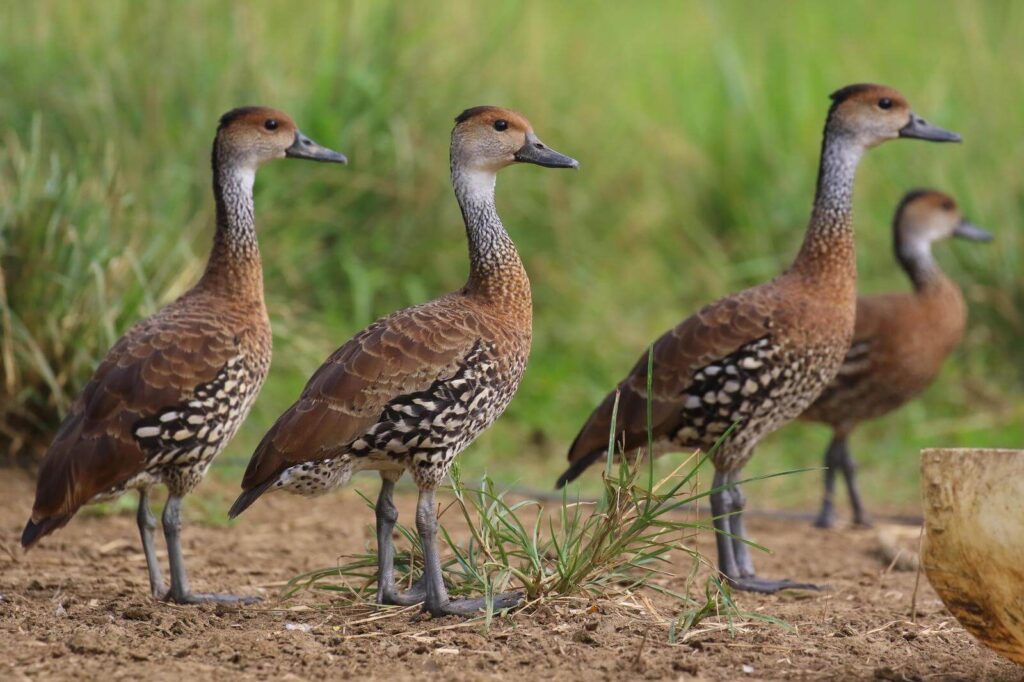
Graceful and quiet, the West Indian Whistling Duck is a beautiful bird found in the Caribbean islands. True to its name, it produces a soft whistling sound that carries across still waters at dusk. This duck often nests in trees, especially in hollows or sturdy branches high above the ground. Sometimes, it will also use dense bushes or even the ground if no tree hollows are available. Its scientific name, Dendrocygna arborea, literally means “of the trees,” highlighting its tree-loving nature. Sadly, this species has faced declines due to habitat loss, but conservation efforts are helping protect its wetland homes.
20. Paradise Shelduck

Native to New Zealand, the Paradise Shelduck is a striking bird — the male has a dark, glossy body, while the female wears a pure white head and chestnut plumage. These ducks like nesting from August to December in sheltered spots such as hollow trees, burrows, or even under old farm buildings. They are often seen in pairs, calling loudly to each other with their distinctive honks. Paradise Shelducks are mainly grazers, feeding on grass and seeds, and they are well-loved in their homeland as a symbol of wild, open countryside.
21. Torrent Duck
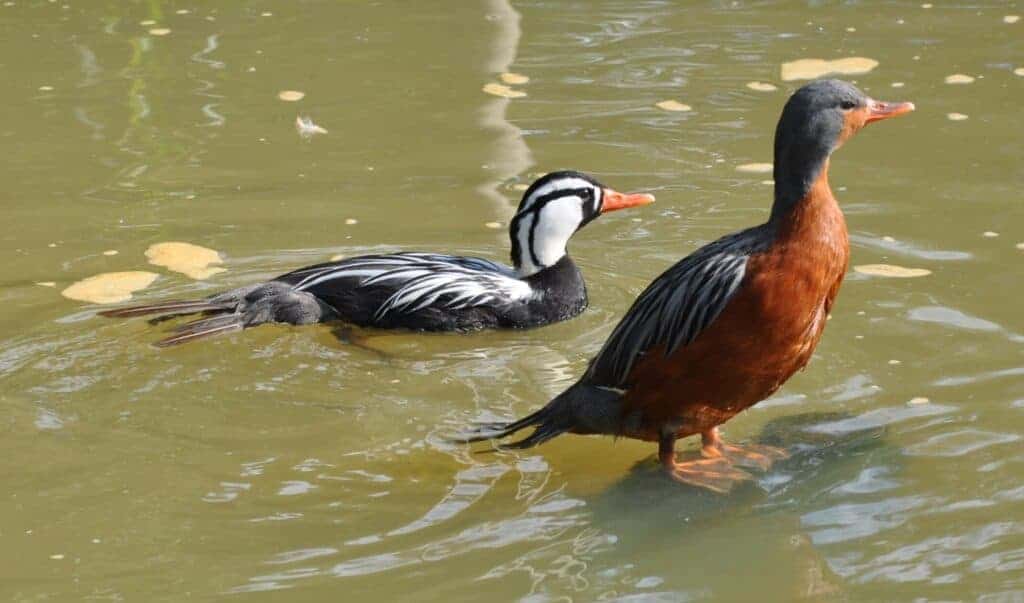
The Torrent Duck is a true river specialist, living along the rushing streams and mountain torrents of South America. Unlike most ducks, it thrives in fast-moving water, using its strong legs and stiff tail to balance on rocks. Its nest is cleverly hidden in deep crevices, hollow trees, or even abandoned caves — sometimes up to 18 meters above the river! This high nesting spot keeps the eggs safe from floods and predators.
22. Ruddy Shelduck

The Ruddy Shelduck is a beautiful orange-brown duck with a gentle black-and-white face and a calm presence. These ducks love lakes, rivers, and wetlands, but they often nest surprisingly far from water — choosing cliffs, tree hollows, or even holes in old buildings. They are strong flyers and highly migratory, traveling great distances between their breeding and wintering grounds. Their loud, honking calls often echo across open landscapes, giving away their presence long before they appear.
23. Cotton Teal (Cotton Pygmy Goose)
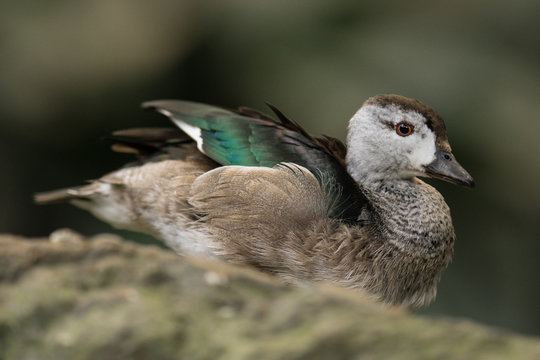
Tiny but full of charm, the Cotton Teal — also known as the Cotton Pygmy Goose — is one of the smallest ducks in the world. Despite its name, it’s more closely related to ducks than true geese. These birds love calm lakes filled with water lilies, where they feed on seeds and aquatic plants. When it’s time to nest, they seek out tree hollows close to water, often just a few meters above the surface. Watching a flock of these little birds gliding smoothly across the water is always a joy — they may be small, but they have big personalities!
